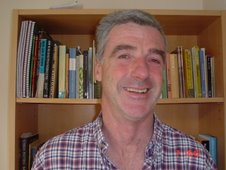Continued from Part 8: Budapest
http://www.impalapublications.com/blog/index.php?/archives/1317-Joining-the-EU-Part-8-Budapest,-by-James-OFee.html
The final trip that József had organised was up the Danube valley, up to the famous Danube Bend where the river makes a right-angled turn south. Our driver was Zolt’s father, ‘Jimmy’ once again. The three of us – Jimmy, József and me – drove along the Danube in bright sunshine, passing Swabian villages with distinctive onion-domed churches.
Our first stop was at a large deserted military camp. This had once home to Austro-Hungarian forces but, latterly, to the Russian Red Army. Now it had been abandoned. We marvelled at the size of the place and I climbed on a giant field-piece which had been left behind.
We took our lunch in a restaurant by the side of the flowing Danube. We had Hungarian fish soup and I chose dark Hungarian beer. It was good!
We drove on to one of the day’s highlights, the impressive castle of Visegrád. The name is Slavic meaning ‘upper castle’ or ‘upper town’. In Czech, the word is spelt Vyšehrad, and the crag of Vyšehrad within modern Prague is the city’s mythical birthplace.
The Hungarian Visegrád Castle crowns a towering peak overlooking the most beautiful section of the great Danube Bend.
http://en.wikipedia.org/wiki/Visegr%C3%A1d
Fortified in the Middle Ages, it became the chief fortress of Hungary and the King’s residence. Perhaps its most memorable moment came in 1335 when the Hungarian King Charles Robert hosted in the castle a conference of the three great Powers of Central Europe – Hungary, Poland and Bohemia – in order to discuss greater co-operation. The other participants at the summit were John of Luxembourg, King of Bohemia, Robert, King of Hungary, and Casimir III of Poland.
This historic meeting is the inspiration for the formation of the Visegrád Group or Visegrád Four, a modern alliance between Poland, the Czech Republic, Slovakia and Hungary.
http://en.wikipedia.org/wiki/Visegrad_Group
At Visegrád we enjoyed the wonderful views of the Danube, the Valley and the surroundings mountains. We passed through the museum with many interesting historical exhibits, including a diorama of the meeting of the three Kings. I took a photo there of one of the attendants who told us that she was a Swabian.
Then back down the Danube a little way to visit Esztergom, the historic centre of Christianity in Hungary and home to the chief Roman Catholic Archbishop of Hungary.
http://en.wikipedia.org/wiki/Esztergom
Naturally we visited the magnificent basilica, with its memorials of, among others, Cardinals Serédy and Mindszenty. Serédy was Archbishop when Patrick Leigh Fermor entered Hungary at Esztergom in 1934 and Leigh Fermor observed the magnificent Easter ceremonial which Serédy conducted. The Communists imprisioned Serédy's successor, Mindszenty and the latter became a beacon of hope for Hungarians suffering the communist yoke.
http://en.wikipedia.org/wiki/J%C3%B3zsef_Cardinal_Mindszenty
In 1934 Patrick Leigh Fermor crossed from Parkán in Slovakia to Esztergom in Hungary by walking over the Maria Valeria bridge, under which he observer a flock of storks fly. Built in 1885, the bridge was destroyed by the retreating Nazis in 1945. It was only rebuilt quite recently with the help of EU money.
Nor does the Danube, the border between Slovakia and Hungary here and for many miles downstream, separate the Slavic Slovaks on the north bank from the Magyars on the south. Both sides of the Danube are inhabited by Magyars – Hungarians. When Slovakia was set up after the First World War, it acquired the Danube border – although the region immediately north of the Danube was a Hungarian-majority area. It contained at least 600,000 people who were one with Hungarian culture.
Crossing the bridge into Slovakia we found that the most dramatic view of the Basilica of Esztergom was seen from the Slovakian bank. Passing into the Hungarian town of Parkán we found a statue to Franz Lehár (Lehár Ferenc) from this area who conquered Vienna with his wonderful operettas.
http://en.wikipedia.org/wiki/Franz_Leh%C3%A1r
Here too József did some shopping, for prices in Slovakia were about 10 per cent lower than in Hungary.
Relations between Slovakia were for many years very bad, on account of Slovakia’s large Magyar minority. With EU entry, happily relations are now much better -athough the extreme Slovak Nationalists continue to obtain a large slice of the vote.
After strolling through Parkán – where everybody spoke Hungarian – we drove through the flood plain encountering a small train on a narrow gauge railway. We reached Komarom, the largest city of the region, some of whose suburbs lie across the Danube and in Hungary proper. Komarom has recently seen a Hungarian-speaking university established in the city, and we were able to stroll around its precincts. We visited the fine City Hall, near which we found a large statue erected to the memory of Komarom’s most famous literary son, Maurus Jokai (Mór Jókai). Jókai was Hungary’s most famous historical novelists of the nineteenth century, in the tradition of Walter Scott.
http://en.wikipedia.org/wiki/M%C3%B3r_J%C3%B3kai
We stopped for a drink in a modern development in the city, but for our evening meal, József had us drive into the Slovakian countryside where a surprise awaited. It was a Slovakian ‘Irish Pub’, with genuine ads for Guinness! After a pleasant meal we made our way outside. The Moon looked very peculiar. József had arranged for a lunar eclipse to take place for us that evening.
To be continued
Friday, 2 February 2007
Subscribe to:
Post Comments (Atom)

No comments:
Post a Comment